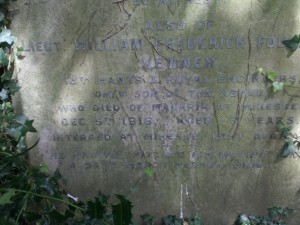William Frederick Fouracre Venner
2nd Lieutenant
13th Battalion Hampshire Regiment attached to the Royal Engineers.
Division 35
 |
 |
William died of Malaria fever in Mikesse, Dar-es-Salaam, German East Africa on December 5th 1916. He was 23 years. He was the only son of late Councillor W.J.D.Venner and grandson of Mrs. M. Venner of “Axbridge”, 76, London Rd. Reading. His father who had been a prominent business man in Reading died in February 1916. William is commemorated on a family grave in the cemetery. Grave number 12576
In the Chronicle 15th December 1916, he is described as “a gallant officer…most promising and had he been spared would undoubtedly have done extremely well in life. Educated at Lord Weymouth’s Grammar school, Warminster…..entered the firm of Messers. M. Venner & Sons of Southampton Street….he joined the first company of Royal Engineers (in 1915) which was formed at Wantage Hall, by the Deputy Mayor Mr Leonard Goodhart Sutton. He quickly obtained his commission and was appointed to the Hants. Regiment but subsequently rejoined the Royal Engineers and was given a position of officer commanding the 49th Motor Air Line Section.”
“Whilst at school he was head of the School Rifle Corps, and took a great interest in St. Giles’ Football club which he helped to found.” He was mourned by his Uncle Mr. R. Venner and other family members, a cousin was in the 32nd Company Royal Engineers also formed by the Deputy Mayor.


![350px-HMS_E20[1]](http://cemeteryjunctionwargraves.org.uk/wp-content/uploads/2013/12/350px-HMS_E201.jpg)
